Power Interference Suppression Method for Measuring Partial Discharges under Pulse Square Voltage Conditions
Abstract
:1. Introduction
2. PD Signal for Simulation Analysis
3. Analysis of Power Interference Suppression
3.1. Circuit Analysis
3.2. Basic Principle of Power Interference Suppression
3.3. Simulation Analysis
4. Measurement of Time Difference and Solution
5. Suppression of Power Interference in Partial Discharge Measurement in the Laboratory
5.1. Experimental Scheme
- (1)
- The partial discharge initial voltage Uc of the insulation sample under power frequency voltage was measured.
- (2)
- The pulse square voltage with a peak value of 0.8 Uc was applied to the insulation sample, where the sampling time was t1 and the measured signal was x1(t).
- (3)
- The signal x2(t) was measured when there is a partial discharge at the insulation sample. The sampling time was t2 (t1 − t2 > T, where T is the period of x1(t)).
- (4)
- The signal x1(t) was processed through the successive interception comparison method, and the corresponding signal X1k(t) was obtained as the benchmark data.
- (5)
- According to the peak-to-peak ratio of the square voltage of the two measurements, the benchmark signal X1k(t) was transformed linearly and the processed signal and signal x2(t) were then inserted into Equation (6) for power interference suppression.
5.2. Experiment and Data Analysis
6. Conclusions
Author Contributions
Funding
Institutional Review Board Statement
Informed Consent Statement
Data Availability Statement
Conflicts of Interest
References
- Borghei, M.; Ghassemi, M. Partial Discharge Analysis under High-Frequency, Fast-Rise Square Wave Voltages in Silicone Gel: A Modeling Approach. Energies 2019, 12, 4543. [Google Scholar] [CrossRef] [Green Version]
- Borghei, M.; Ghassemi, M. A Finite Element Analysis Model for Partial Discharges in Silicone Gel under a High Slew Rate, High-Frequency Square Wave Voltage in Low-Pressure Conditions. Energies 2020, 13, 2152. [Google Scholar] [CrossRef]
- Abdelmalik, A.A. Influence of sinusoidal and square voltages on partial discharge inception in geometries with point-like termination. High Volt. 2018, 3, 31–37. [Google Scholar] [CrossRef]
- Wang, P.; Yang, N.; Zheng, C.; Li, Y. Effect of repetitive impulsive and square wave voltage frequency on partial discharge features. In Proceedings of the 2018 12th International Conference on the Properties and Applications of Dielectric Materials (ICPADM), Xi’an, China, 20–24 May 2018; pp. 152–155. [Google Scholar] [CrossRef]
- Zhao, Y.; Li, Y.; Li, K.; Han, D.; Qiu, Z.; Zhang, G. Emission Spectrum Analysis of Two Typical Partial Discharge Forms under High Frequency Square Wave Voltages. IEEE Access 2020, 8, 219946–219954. [Google Scholar] [CrossRef]
- Abdelmalik, A.A.; Nysveen, A.; Lundgaard, L.E. Partial discharges in liquid embedded power electronics: Effects of pressure and liquid nature under negative pulse voltage stress. IEEE Trans. Dielectr. Electr. Insul. 2016, 23, 1119–1125. [Google Scholar] [CrossRef]
- You, H.; Wei, Z.; Hu, B.; Zhao, Z.; Na, R.; Wang, J. Partial Discharge Behaviors in Power Modules under Square Pulses with Ultrafast dv/dt. IEEE Trans. Power Electron. 2020, 36, 2611–2620. [Google Scholar] [CrossRef]
- Li, L.; Wei, X. Suppression Method of Partial Discharge Interferences Based on Singular Value Decomposition and Improved Empirical Mode Decomposition. Energies 2021, 14, 8579. [Google Scholar] [CrossRef]
- Illias, H.A.; Bakar, A.H.A.; Mokhlis, H.; Tunio, M.A.; Chen, G.; Lewin, P.L.; Ariffin, A.M. Simulation of partial discharge within a void under square waveform applied voltage. In Proceedings of the 2012 Annual Report Conference on Electrical Insulation and Dielectric Phenomena, Montreal, QC, Canada, 14–17 October 2012; pp. 76–79. [Google Scholar] [CrossRef] [Green Version]
- Qi, W.; Gao, S.; Xia, Y.; Gui, J.; Lin, J.; Huang, J.; Chen, X. Suppression of pulse interference in partial discharge measurement based on phase correlation and waveform characteristics. In Proceedings of the 2014 International Conference on Power System Technology, Chengdu, China, 20–22 October 2014; pp. 1338–1341. [Google Scholar] [CrossRef]
- Florkowska, B.; Roehrich, J.; Zydron, P.; Florkowski, M. Measurement and analysis of surface partial discharges at semi-square voltage waveforms. IEEE Trans. Dielectr. Electr. Insul. 2011, 18, 990–996. [Google Scholar] [CrossRef]
- Nguyen, H.V.P.; Phung, B.T.; Blackburn, T. Partial discharge behaviors in cavities under square voltage excitation at very low frequency. In Proceedings of the 2016 International Conference on Condition Monitoring and Diagnosis (CMD), Xi’an, China, 20–25 September 2016; pp. 866–869. [Google Scholar] [CrossRef]
- Wang, P.; Xu, H.; Wang, J.; Cavallini, A. The influence of repetitive square wave voltage duty cycle on partial discharge statistics and insulation endurance. In Proceedings of the 2016 International Conference on Condition Monitoring and Diagnosis (CMD), Xi’an, China, 20–25 September 2016; pp. 274–277. [Google Scholar] [CrossRef]
- Chen, X.; Cao, B.; Wu, G.; Gao, G.; Sun, J.; Gu, Z. Use of UHF method to measure partial discharge signal under square quare-wave pulse. In Proceedings of the 2014 International Symposium on Electrical Insulating Materials, Niigata, Japan, 1–5 June 2014; pp. 188–191. [Google Scholar] [CrossRef]
- Jiang, J.; Zhang, B.; Li, Z.; Ranjan, P.; Chen, J.; Zhang, C. Partial Discharge Features for Power Electronic Transformers under High-Frequency Pulse Voltage. IEEE Trans. Plasma Sci. 2021, 49, 845–853. [Google Scholar] [CrossRef]
- Hu, B.; Wei, Z.; You, H.; Na, R.; Liu, R.; Xiong, H.; Fu, P.; Zhang, J.G.; Wang, J. A Partial Discharge Study of Medium-Voltage Motor Winding Insulation under Two-Level Voltage Pulses with High Dv/Dt. IEEE Open J. Power Electron. 2021, 2, 225–235. [Google Scholar] [CrossRef]
- Wang, P.; Cavallini, A.; Montanari, G.C. Characteristics of PD under square wave voltages and their influence on motor insulation endurance. EEE Trans. Dielectr. Electr. Insul. 2015, 22, 3079–3086. [Google Scholar] [CrossRef]
- Wang, P.; Cavallini, A.; Montanari, G.C.; Wu, G. Effect of rise time on PD pulse features under repetitive square wave voltages. IEEE Trans. Dielectr. Electr. Insul. 2013, 20, 245–254. [Google Scholar] [CrossRef]
- Wu, K.; Okamoto, T.; Suzuoki, Y. Effects of discharge area and surface conductivity on partial discharge behavior in voids under square voltages. IEEE Trans. Dielectr. Electr. Insul. 2007, 14, 461–470. [Google Scholar] [CrossRef]
- Baug, A.; Choudhury, N.R.; Ghosh, R.; Dalai, S.; Chatterjee, B. Identification of single and multiple partial discharge sources by optical method using mathematical morphology aided sparse representation classifier. IEEE Trans. Dielectr. Electr. Insul. 2017, 24, 3703–3712. [Google Scholar] [CrossRef]
- Santos, M.G.; Braulio, G.A.; Bernardes, J.V.; De Salles, C.; Milanez, J.R.C.; Bortoni, E.C.; Bastos, G.S. Continuous Partial Discharges Analysis during Automated Thermal Cycle Aging Experiment. IEEE Trans. Energy Convers. 2020, 35, 1989–1992. [Google Scholar] [CrossRef]
- Wu, Y.; Wang, G.; Bi, J.; Li, J.; Peng, X.; Liu, T. Interference Rejection of High Voltage Cables Partial Discharge Detection Based on Combination Features Analysis. In Proceedings of the 2019 IEEE PES Asia-Pacific Power and Energy Engineering Conference (APPEEC), Macao, China, 1–4 December 2019; pp. 1–5. [Google Scholar]
- Rajendran, A.; Meena, K.P.; Buijupati, N.R. Simulation of partial discharges and implementation of noise elimination techniques. In Proceedings of the 2017 3rd International Conference on Condition Assessment Techniques in Electrical Systems (CATCON), Rupnagar, India, 16–18 November 2017; pp. 412–417. [Google Scholar]
- Shams, M.A.; Anis, H.I.; El-Shahat, M. Denoising of Heavily Contaminated Partial Discharge Signals in High-Voltage Cables Using Maximal Overlap Discrete Wavelet Transform. Energies 2021, 14, 6540. [Google Scholar] [CrossRef]
- Soltani, A.A.; El-Hag, A. Denoising of Radio Frequency Partial Discharge Signals Using Artificial Neural Network. Energies 2019, 12, 3485. [Google Scholar] [CrossRef] [Green Version]
- Zhu, J.; He, B.; Wang, X.; Cui, L.; Li, Y. Extraction of Partial Discharge Signal Feature Based on Dual-tree Complex Wave-let Transform and Singular-value Decomposition. In Proceedings of the 2018 Condition Monitoring and Diagnosis (CMD), Perth, WA, Australia, 23–26 September 2018; pp. 1–5. [Google Scholar]
- Ran, H.; Xu, Y.; Jiang, J.; Tang, K.; He, Z.; Zhang, T.; Tang, X. Application of Singular Value Reconstruction in Suppressing Narrowband Interference of Partial Discharge. In Proceedings of the 2019 4th International Conference on Power and Renewable Energy (ICPRE), Chengdu, China, 21–23 September 2019; pp. 239–243. [Google Scholar]
- Zhou, K.; Li, M.; Li, Y.; Xie, M.; Huang, Y. An Improved Denoising Method for Partial Discharge Signals Contaminated by White Noise Based on Adaptive Short-Time Singular Value Decomposition. Energies 2019, 12, 3465. [Google Scholar] [CrossRef] [Green Version]
- Wei, L.; Liu, Y.; Cheng, D.; Li, P.; Shi, Z.; Huang, N.; Ai, H.; Zhu, T. A Novel Partial Discharge Ultra-High Frequency Signal De-Noising Method Based on a Single-Channel Blind Source Separation Algorithm. Energies 2018, 11, 509. [Google Scholar] [CrossRef] [Green Version]
- Zhong, J.; Bi, X.; Shu, Q.; Chen, M.; Zhou, D.; Zhang, D. Partial Discharge Signal Denoising Based on Singular Value Decomposition and Empirical Wavelet Transform. IEEE Trans. Instrum. Meas. 2020, 69, 8866–8873. [Google Scholar] [CrossRef]
- Govindarajan, S.; Subbaiah, J.; Cavallini, A.; Krithivasan, K.; Jayakumar, J. Partial Discharge Random Noise Removal Using Hankel Matrix-Based Fast Singular Value Decomposition. IEEE Trans. Instrum. Meas. 2019, 69, 4093–4102. [Google Scholar] [CrossRef]
- Yang, X.; Huang, H.; Shu, Q.; Zhang, D.; Chen, B. Partial Discharge Signal Extraction Method Based on EDSSV and Low Rank RBF Neural Network. IEEE Access 2021, 9, 9744–9752. [Google Scholar] [CrossRef]
- Barbi, I. A Theorem on Power Superposition in Resistive Networks. IEEE Trans. Circuits Syst. II Express Briefs 2021, 68, 2362–2363. [Google Scholar] [CrossRef]
- Leni, P.E.; Fougerolle, Y.D.; Truchetet, F. Kolmogorov Superposition Theorem and Wavelets for image compression. IET Image Process. 2010, 6, 753502. [Google Scholar]
- Zhang, Z.; Shen, A.; Li, P.; Luo, X.; Tang, Q. MTPA-based high-frequency square wave voltage signal injection strategy for IPMSM control. J. Power Electron. 2021, 21, 1461–1472. [Google Scholar] [CrossRef]
- Karakaya, F.; Gülsuna, Ö.; Keysan, O. Feasibility of Quasi-Square-Wave Zero-Voltage-Switching Bi-Directional DC/DC Converters with GaN HEMTs. Energies 2021, 14, 2867. [Google Scholar] [CrossRef]
- Shen, L.; Xie, F.; Xiao, W.; Ji, H.; Zhang, B. Thermal Analyses of Reactor under High-Power and High-Frequency Square Wave Voltage Based on Improved Thermal Network Model. Electronics 2021, 10, 1342. [Google Scholar] [CrossRef]
- Zhang, T.; Mandala, A.T.; Zhong, T.; Jiang, S.; Zhang, N. The Dielectric Voltage Response Characteristics of Transformer Oil–Paper Insulation and Its Aging State Assessment. MAPAN 2022. [Google Scholar] [CrossRef]
- Luo, B.; Wang, J.; Dai, D.; Jia, L.; Li, L.; Wang, T. Partial Discharge Simulation of Air Gap Defects in Oil-Paper Insulation Paperboard of Converter Transformer under Different Ratios of AC–DC Combined Voltage. Energies 2021, 14, 6995. [Google Scholar] [CrossRef]
- Zukowski, P.; Rogalski, P.; Kierczynski, K.; Koltunowicz, T.N. Precise Measurements of the Temperature Influence on the Complex Permittivity of Power Transformers Moistened Paper-Oil Insulation. Energies 2021, 14, 5802. [Google Scholar] [CrossRef]
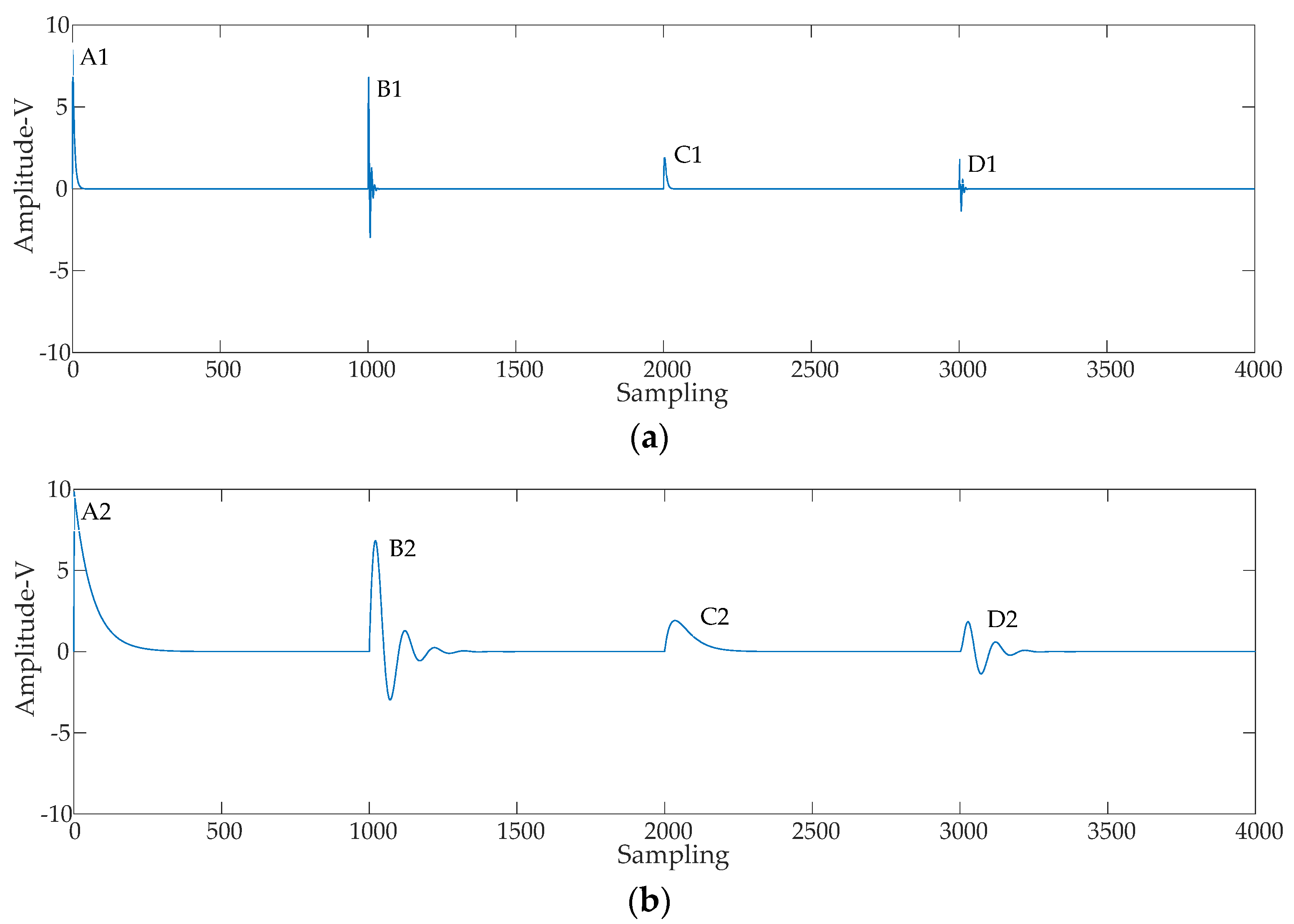

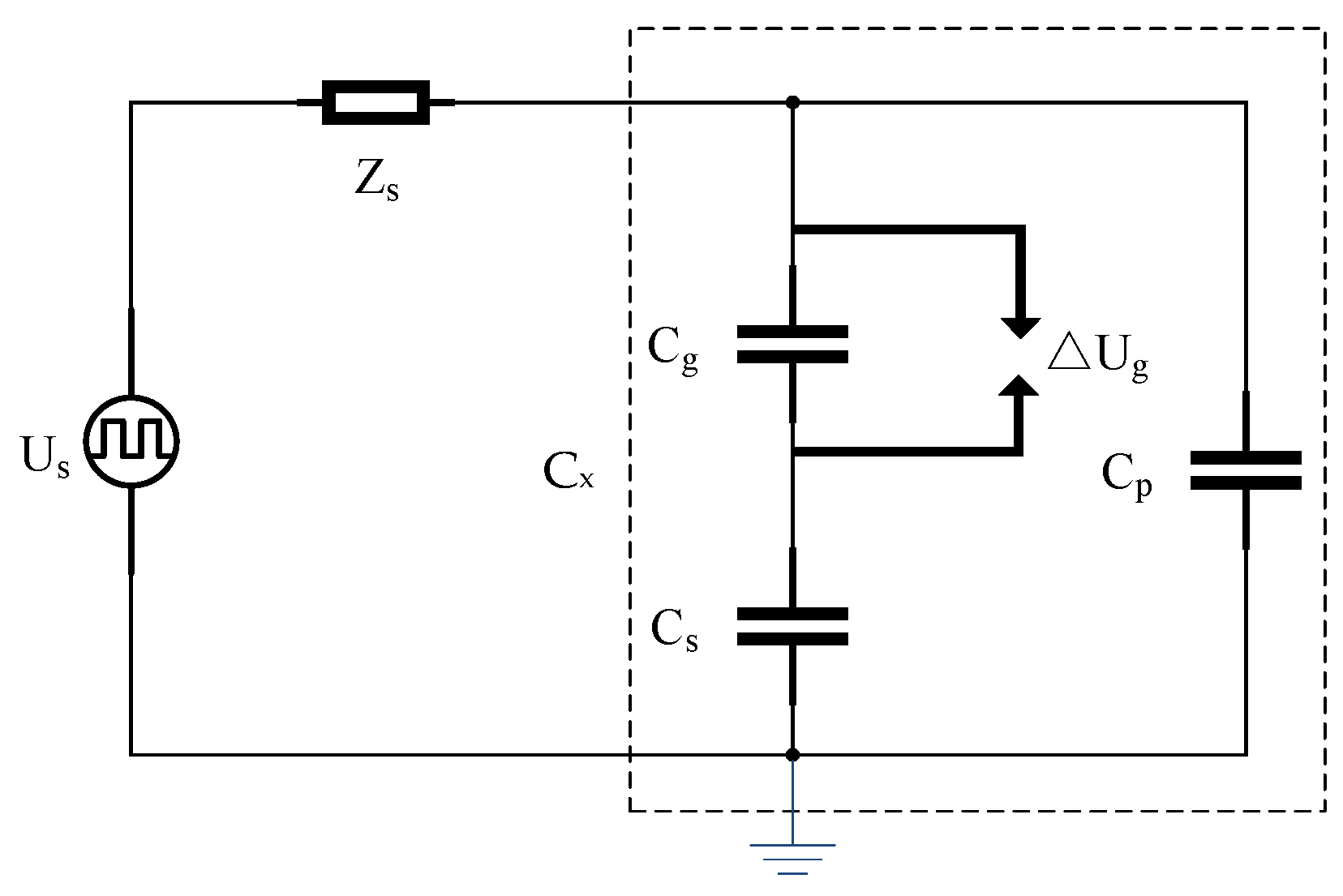
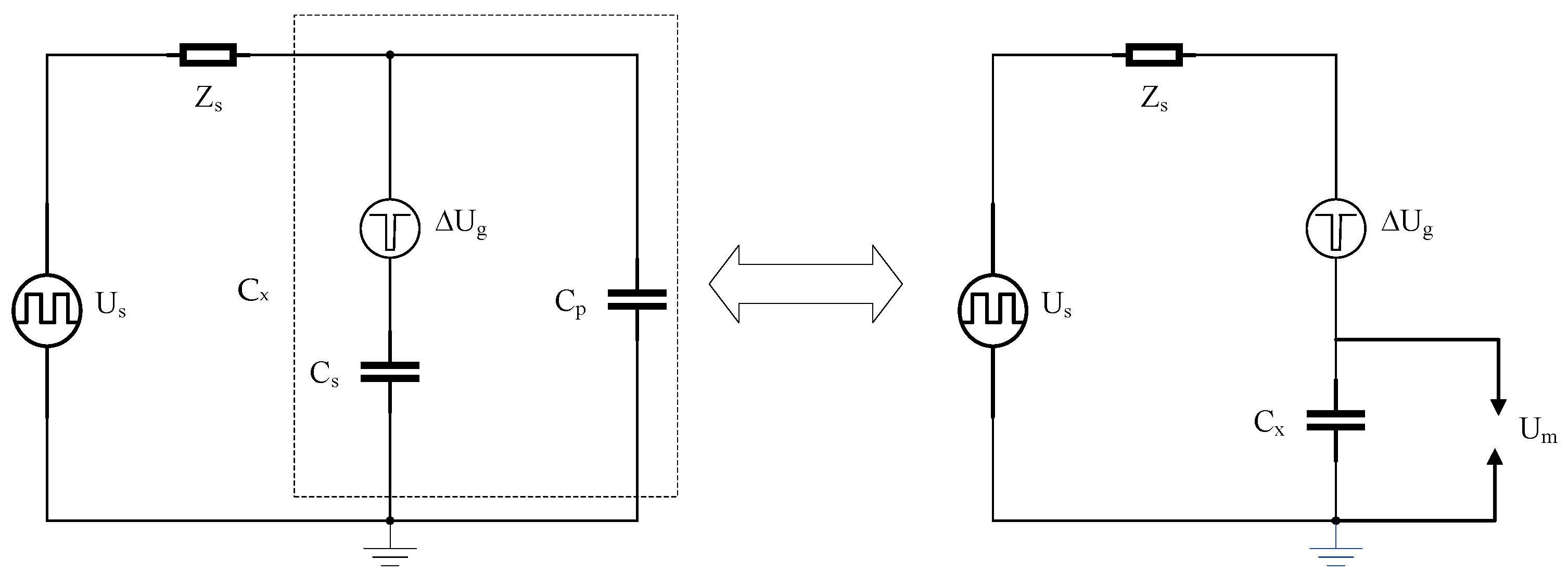



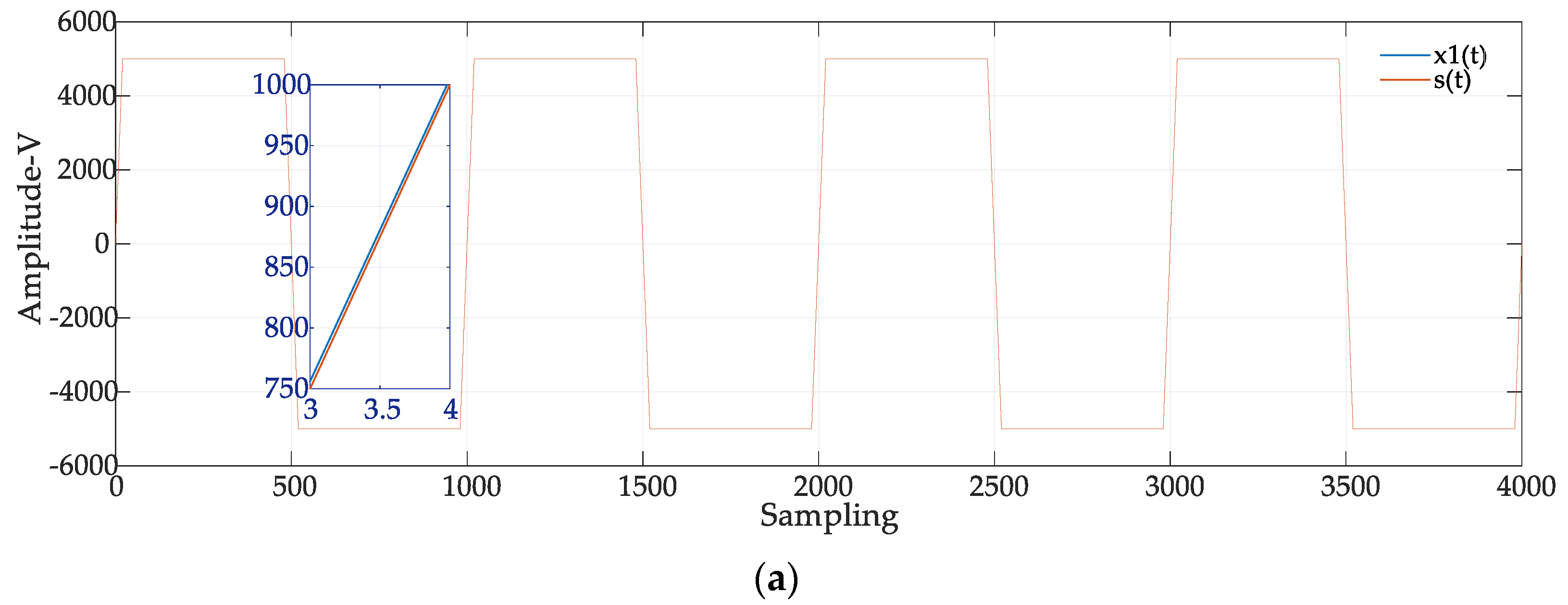

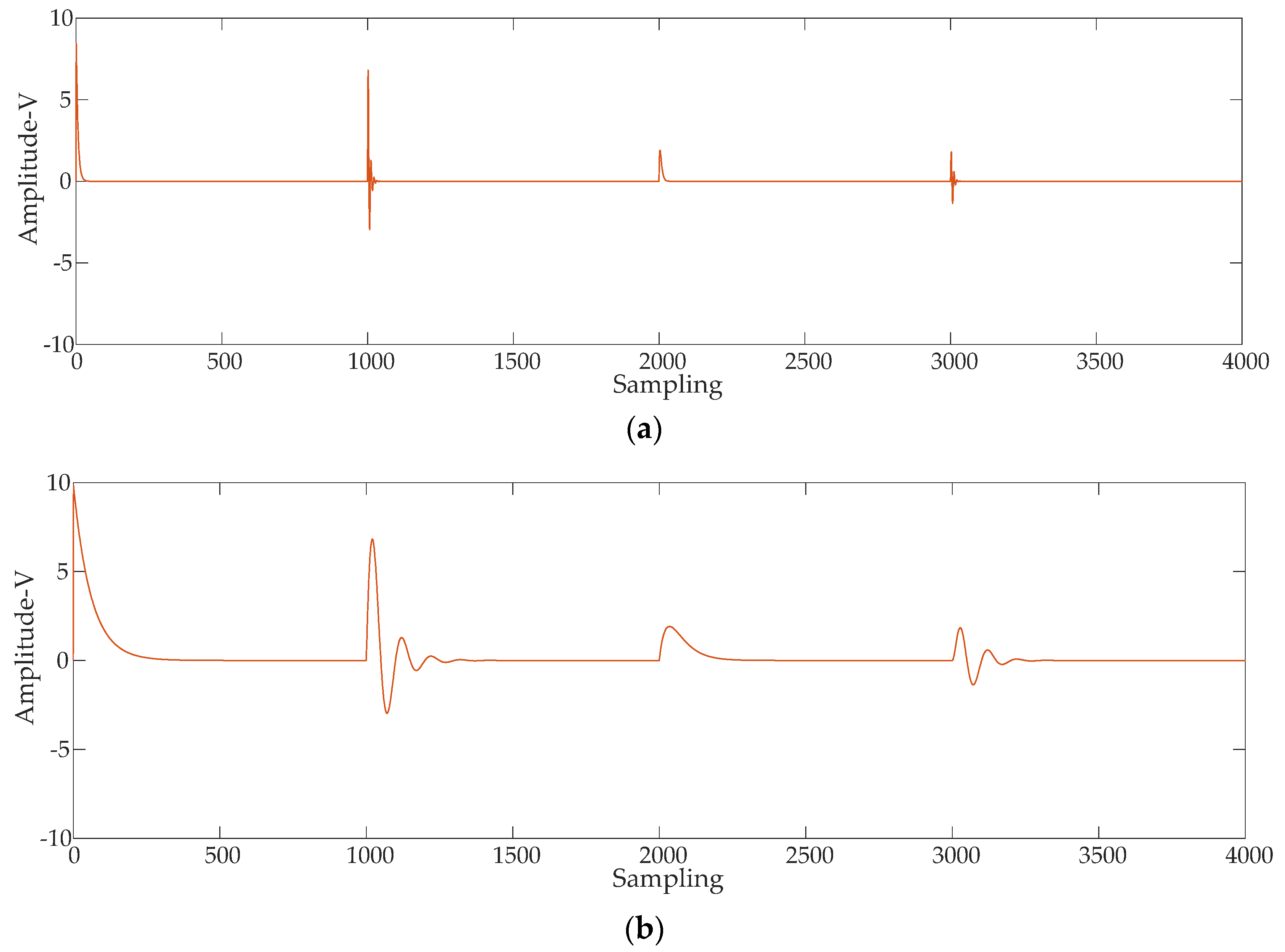


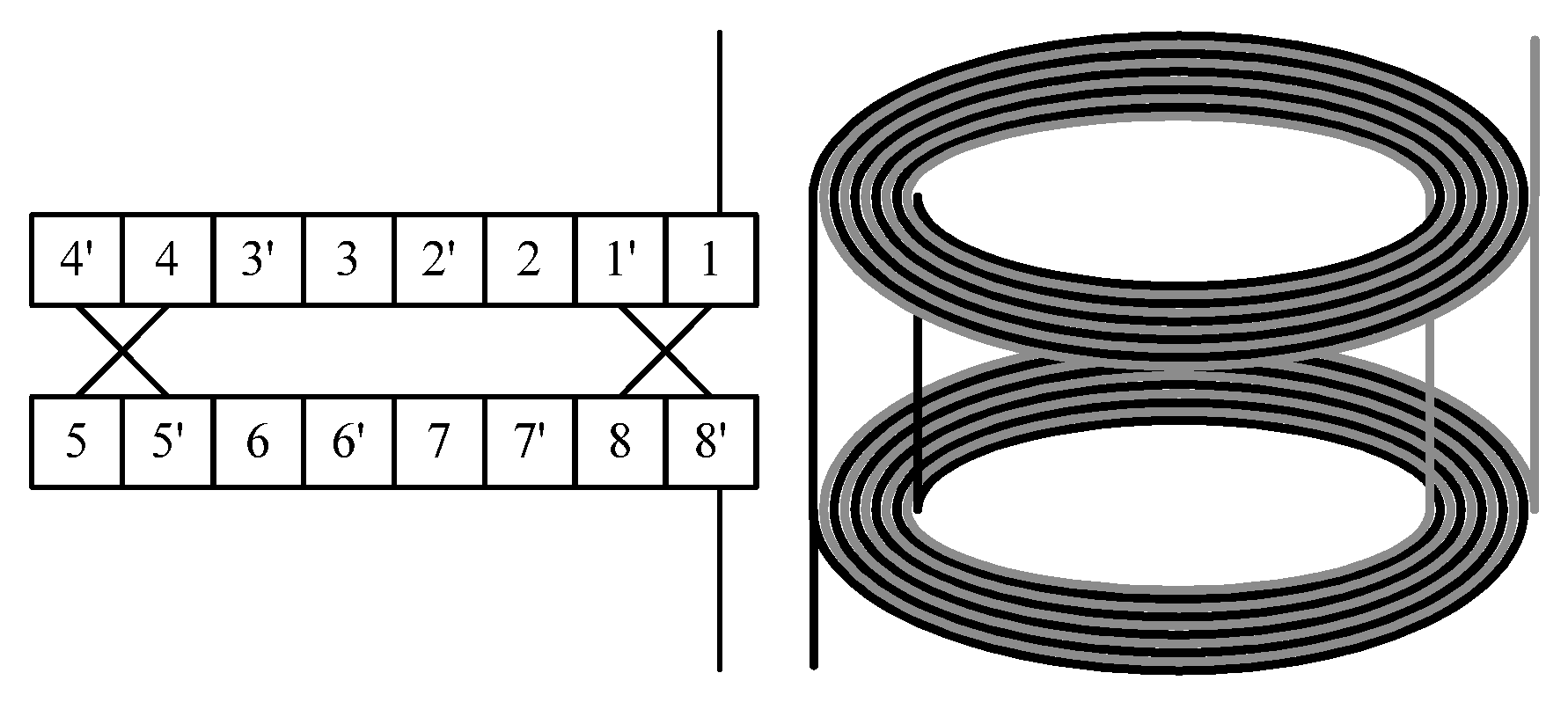

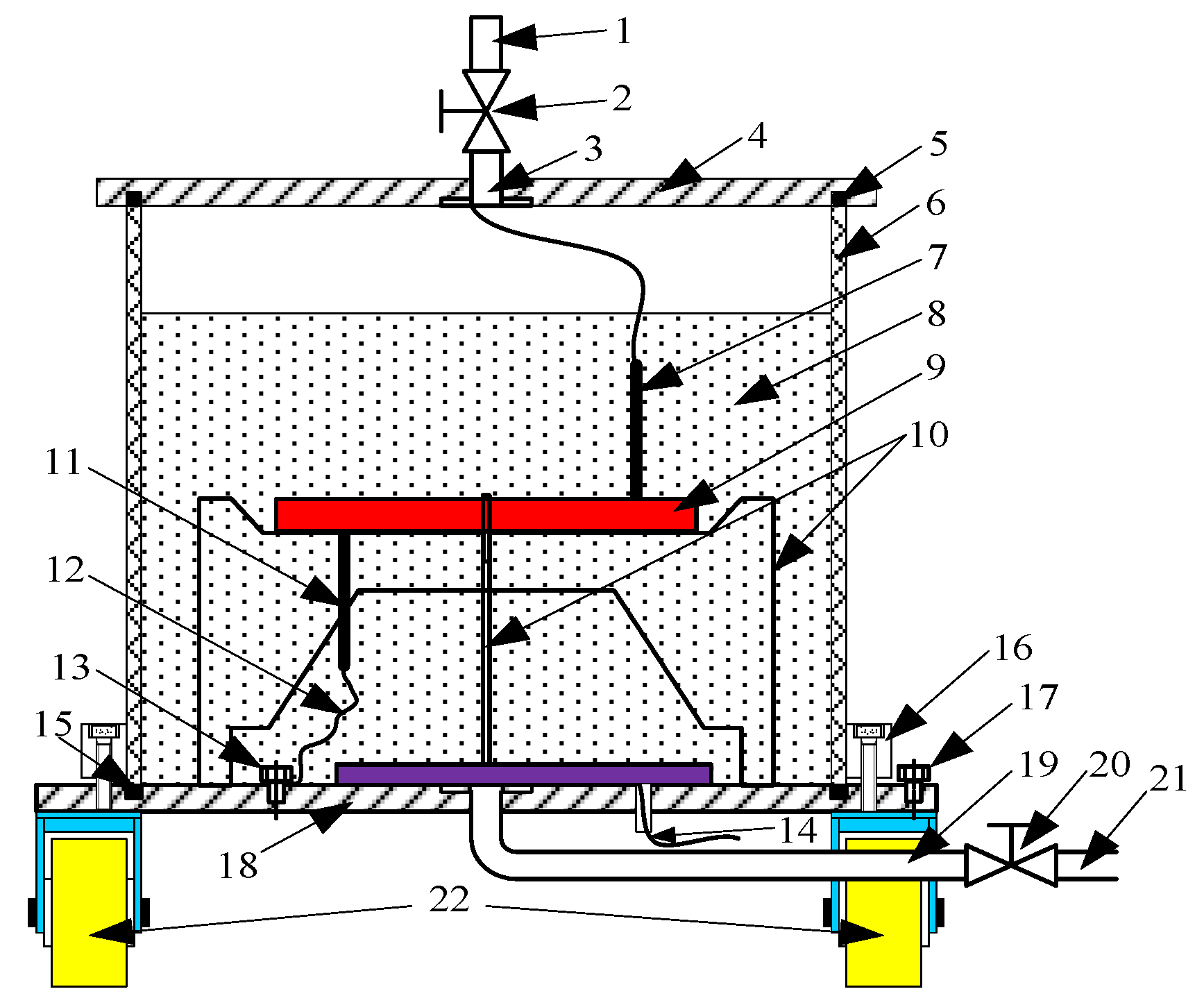

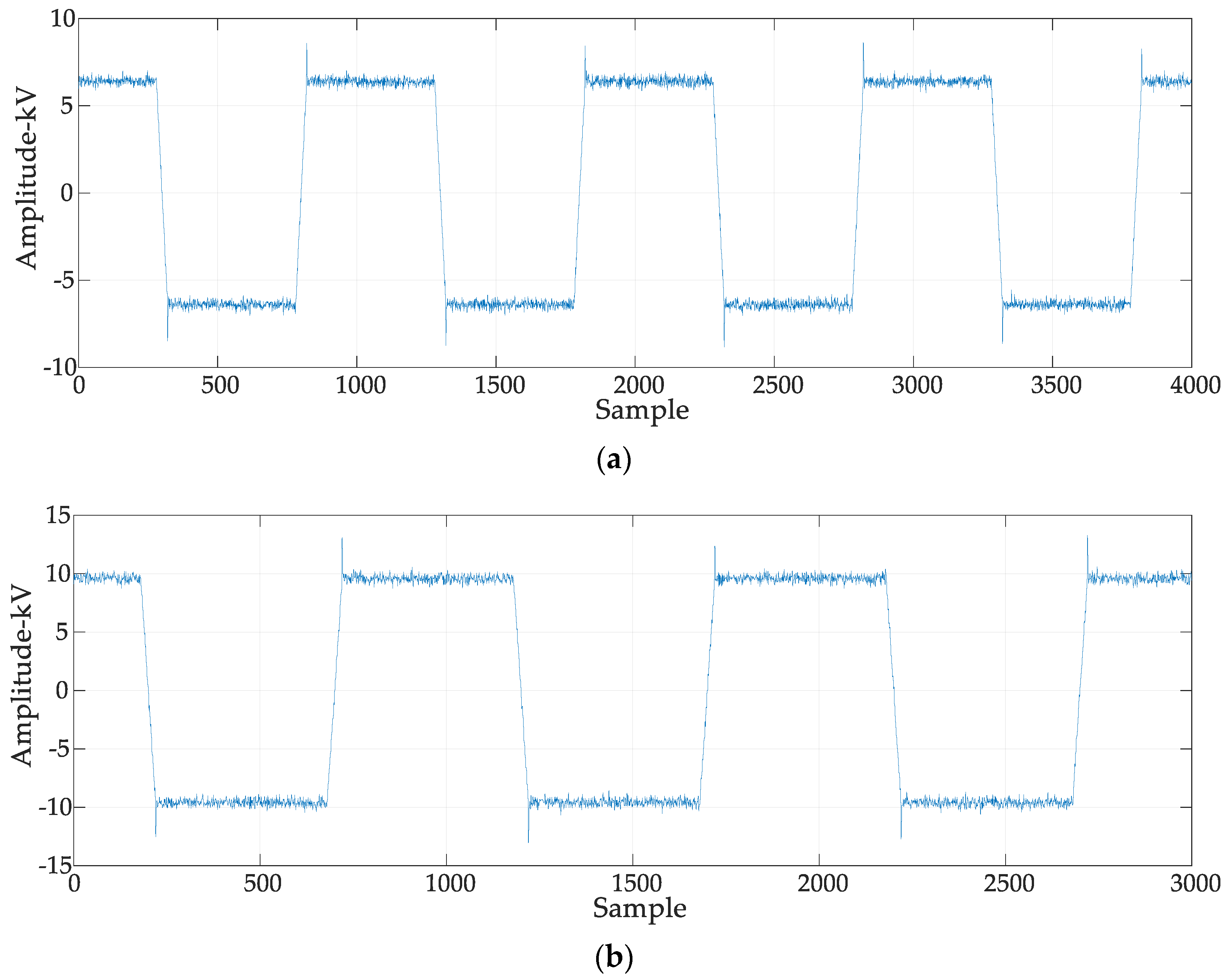
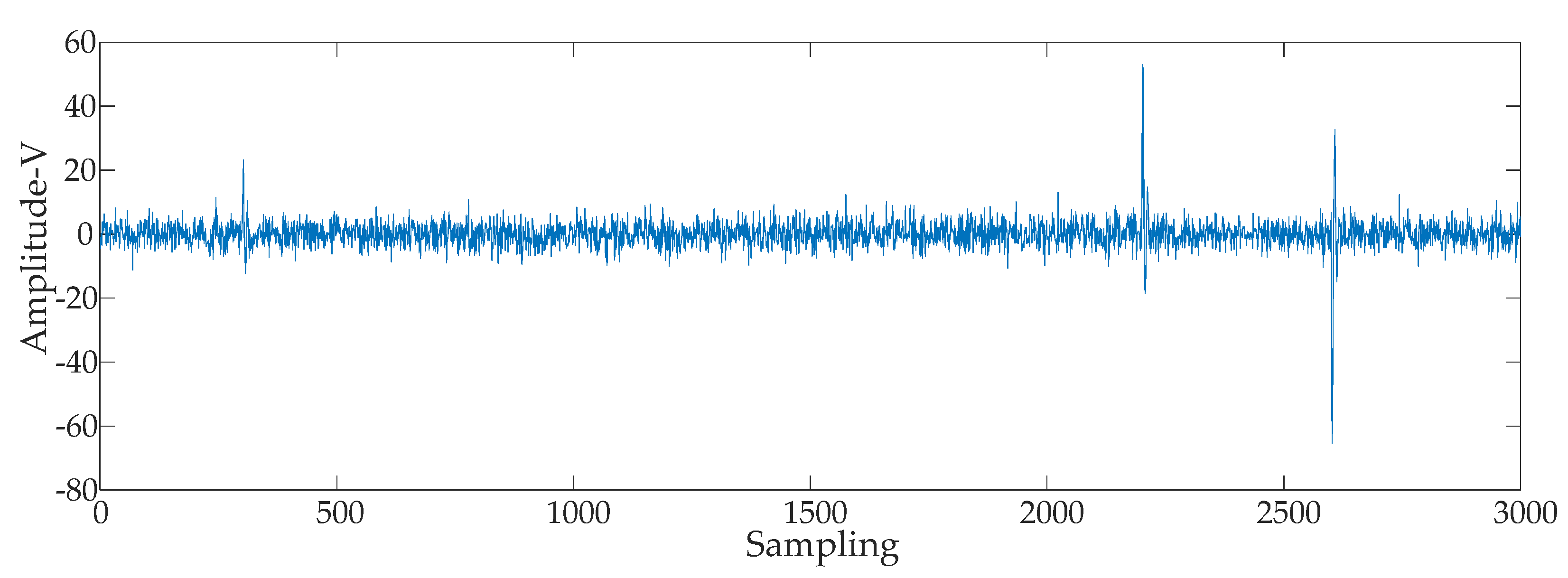

| Partial Discharge (PD) Pulse | A1 | B1 | C1 | D1 |
| Signal amplitude (A/V) | 10 | 10 | 10 | 10 |
| Oscillation frequency (fc/MHz) | - | 2 | - | 2 |
| Attenuation coefficient (τ/μs) | 0.3 | 0.3 | 0.3 | 0.3 |
| Time of PD (t0/μs) | 0 | 50 | 100 | 150 |
| Partial Discharge (PD) Pulse | A2 | B2 | C2 | D2 |
| Signal amplitude (A/V) | 10 | 10 | 20 | 20 |
| Oscillation frequency (fc/MHz) | - | 0.2 | - | 0.2 |
| Attenuation coefficient (τ/μs) | 3 | 3 | 3 | 3 |
| Time of PD (t0/μs) | 0 | 50 | 100 | 150 |
Publisher’s Note: MDPI stays neutral with regard to jurisdictional claims in published maps and institutional affiliations. |
© 2022 by the authors. Licensee MDPI, Basel, Switzerland. This article is an open access article distributed under the terms and conditions of the Creative Commons Attribution (CC BY) license (https://creativecommons.org/licenses/by/4.0/).
Share and Cite
Li, L.; Wei, X. Power Interference Suppression Method for Measuring Partial Discharges under Pulse Square Voltage Conditions. Energies 2022, 15, 3437. https://doi.org/10.3390/en15093437
Li L, Wei X. Power Interference Suppression Method for Measuring Partial Discharges under Pulse Square Voltage Conditions. Energies. 2022; 15(9):3437. https://doi.org/10.3390/en15093437
Chicago/Turabian StyleLi, Linao, and Xinlao Wei. 2022. "Power Interference Suppression Method for Measuring Partial Discharges under Pulse Square Voltage Conditions" Energies 15, no. 9: 3437. https://doi.org/10.3390/en15093437
APA StyleLi, L., & Wei, X. (2022). Power Interference Suppression Method for Measuring Partial Discharges under Pulse Square Voltage Conditions. Energies, 15(9), 3437. https://doi.org/10.3390/en15093437







